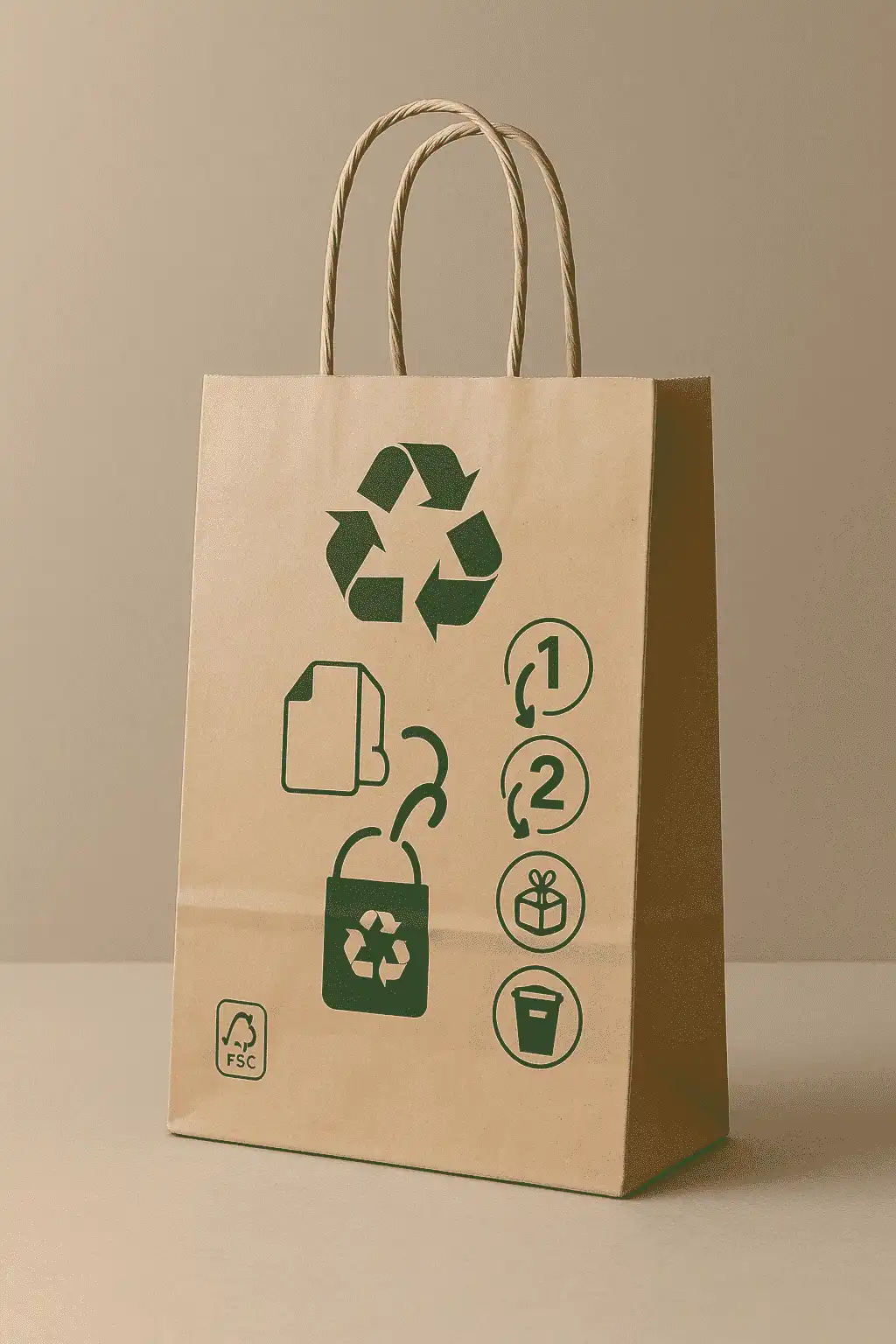How to Recycle Paper Shopping Bags: A Step-by-Step Guide?
Are you overwhelmed by the pile of Paper Shopping Bags accumulating in your home, wondering whether they're destined for the landfill or can be given a second life? This comprehensive guide addresses the growing concern of sustainable waste management by providing you with clear, actionable steps to properly recycle Paper Shopping Bags. With environmental consciousness at an all-time high, understanding the recycling process for these everyday items has become crucial for responsible consumers who want to minimize their ecological footprint while maximizing the utility of these versatile packaging solutions.

Understanding Paper Shopping Bags and Their Environmental Impact
Paper Shopping Bags represent a significant improvement over plastic alternatives in terms of environmental sustainability. These bags, commonly manufactured from kraft paper, recycled content, or premium paperboard materials, offer biodegradable properties that make them inherently more eco-friendly than their plastic counterparts. The environmental benefits of Paper Shopping Bags extend beyond their biodegradability, as they can be recycled multiple times through established waste management systems.
Most Paper Shopping Bags are produced using renewable wood fiber sources, often incorporating FSC-certified materials that ensure responsible forestry practices. The manufacturing process typically involves creating paper from either virgin wood pulp or recycled paper content, which means that when you recycle Paper Shopping Bags, you're contributing to a circular economy that reduces the demand for new raw materials. Understanding the composition of your Paper Shopping Bags is essential because different materials require different recycling approaches, and bags with plastic coating, wax treatments, or laminated surfaces may not be suitable for standard paper recycling streams.
-
Types of Paper Shopping Bags and Their Recycling Compatibility
Different materials used in Paper Shopping Bags affect their recyclability. Premium bags made from SBS C1S or SBS C2S paperboard, which feature smooth printing surfaces and excellent structural integrity, are typically fully recyclable through standard paper recycling programs. CCNB (Clay Coated News Back) bags, made from recycled fibers with clay-coated fronts, are also recyclable and represent an economical choice that supports sustainability initiatives. Brown kraft Paper Shopping Bags, manufactured from unbleached wood pulp, offer excellent recyclability while maintaining their natural appearance and high tensile strength.
Metallic Paper Shopping Bags present unique challenges for recycling due to their foil lamination or metallic coating applications. While these bags create exceptional visual impact and luxury appeal, the mixed materials make them unsuitable for standard paper recycling processes. Understanding these material differences helps consumers make informed decisions about both purchasing and disposal of Paper Shopping Bags.
Step-by-Step Paper Shopping Bag Recycling Process
The recycling process for Paper Shopping Bags involves several systematic steps that transform used bags into new paper products. The process begins with collection from curbside bins or drop-off locations, followed by transportation to recycling facilities where bags are sorted from other recyclables using conveyor belt systems. This initial sorting phase is crucial because contaminated or non-recyclable materials can compromise entire batches of recycled content.
Once sorted, Paper Shopping Bags undergo a breakdown process involving water, heat, and mechanical blending that separates the paper fibers from any adhesives or contaminants. The resulting pulp is then screened to remove debris, cleaned to eliminate inks and coatings, and processed into new paper products. This transformation process can convert your used Paper Shopping Bags into new packaging materials, newsprint, cardboard, or other paper products, effectively extending the lifecycle of the original materials.
-
Preparing Your Paper Shopping Bags for Recycling
Proper preparation of Paper Shopping Bags significantly improves their recyclability and reduces contamination in recycling streams. Begin by removing all non-paper components, including plastic handles, ribbon attachments, metal grommets, or adhesive labels that cannot be processed with paper materials. Twisted paper handles and cotton rope handles are generally acceptable for recycling along with the bag, as these natural fiber components integrate well with the paper recycling process.
Clean your Paper Shopping Bags by removing any food residue, grease stains, or other contaminants that could interfere with the recycling process. Bags with minimal contamination can often be cleaned with a dry cloth, while heavily soiled bags may need to be discarded in regular waste if cleaning is not possible. Flatten the bags to save space and make sorting easier at recycling facilities, then bundle them with other paper products to prevent them from becoming separated during collection and transport.
Local Recycling Programs and Paper Shopping Bags
Most communities offer recycling programs that accept Paper Shopping Bags, but it's important to verify acceptance with your local recycling facility as program requirements vary by location. Many municipal recycling programs include Paper Shopping Bags in their regular curbside collection, provided they meet cleanliness and material requirements. Some areas may require Paper Shopping Bags to be placed in designated paper recycling bins or bundled separately from other recyclables.
Drop-off recycling centers often provide more flexible options for Paper Shopping Bags recycling, accepting bags that might not qualify for curbside pickup due to size, material composition, or condition. These facilities typically have specialized sorting equipment that can handle a wider variety of paper products and may accept bags with minor contamination that would be rejected by automated curbside processing systems. Contact your local waste management authority or visit their website to understand specific requirements for Paper Shopping Bags in your recycling program.
-
Commercial Recycling Options for Paper Shopping Bags
Retail stores and businesses that generate large quantities of Paper Shopping Bags often participate in commercial recycling programs that offer more comprehensive collection and processing services. These programs frequently accept bags with various handle types, including twisted paper handles, cotton rope handles, and satin ribbon handles, provided the materials can be separated during processing. Many commercial recycling services also accept bags with specialty printing, including CMYK full-color designs and Pantone spot colors, as modern recycling processes can effectively remove most printing inks.
Businesses using Paper Shopping Bags made from premium materials like SBS C1S or SBS C2S can often achieve higher recycling rates through specialized commercial programs that value these high-quality fiber sources. Companies that prioritize sustainability may choose to work with recycling partners who can provide detailed reporting on recycling rates and environmental impact, helping track the lifecycle of their Paper Shopping Bags from distribution through recycling and remanufacturing.
Creative Reuse Ideas Before Recycling Paper Shopping Bags
Before sending Paper Shopping Bags to recycling facilities, consider extending their usefulness through creative reuse applications that maximize their value and delay their entry into waste streams. Paper Shopping Bags can be transformed into emergency notebooks by cutting them into rectangular sheets, stacking them, and binding them together for note-taking purposes. This approach is particularly valuable for parents, students, or professionals who need quick, eco-friendly writing solutions.
Sturdy Paper Shopping Bags with reinforced bottoms and quality construction make excellent storage containers for organizing seasonal items, craft supplies, or household goods. The natural kraft appearance of brown Paper Shopping Bags complements rustic or minimalist decor styles, while bags with attractive printing can serve decorative storage functions. Gift wrapping represents another excellent reuse opportunity, as larger Paper Shopping Bags can be cut and decorated to create custom wrapping paper for presents, reducing the need for purchasing new wrapping materials.
-
Upcycling Projects Using Paper Shopping Bags
Paper Shopping Bags offer excellent material for various upcycling projects that transform them into useful household items. The strong construction of quality bags made from materials like kraft paper or premium paperboard makes them suitable for creating magazine holders, file organizers, or desktop storage systems. Simple cutting and folding techniques can convert large Paper Shopping Bags into smaller containers perfectly sized for organizing drawers or closet shelves.
Art and craft projects benefit from the versatile nature of Paper Shopping Bags, which can be painted, decorated, or combined with other materials to create custom storage solutions or decorative items. Children's craft projects often incorporate Paper Shopping Bags as base materials for masks, puppets, or educational models, providing both creative outlets and environmental education opportunities. The variety of handle types, from twisted paper to cotton rope to satin ribbon options, adds textural interest to craft projects while maintaining the eco-friendly nature of the base materials.
Maximizing the Environmental Benefits of Paper Shopping Bag Recycling
Proper recycling of Paper Shopping Bags contributes significantly to environmental conservation by reducing the demand for virgin wood fiber and decreasing landfill waste accumulation. The environmental benefits multiply when consumers choose bags made from FSC-certified materials and recycled content, as these choices support sustainable forestry practices and circular economy principles. Understanding the full lifecycle impact of Paper Shopping Bags helps consumers make informed decisions about purchasing, use, and disposal practices.
The energy savings achieved through Paper Shopping Bags recycling are substantial compared to manufacturing new paper products from virgin materials. Recycled paper production typically requires 60% less energy than virgin paper manufacturing, while also reducing water consumption and air emissions associated with traditional paper production processes. These environmental benefits become more significant as recycling rates increase and more consumers participate in proper Paper Shopping Bags disposal programs.
Conclusion
Recycling Paper Shopping Bags effectively requires understanding material types, proper preparation techniques, and local recycling program requirements. By following these systematic steps, consumers can ensure their bags contribute to environmental sustainability while supporting circular economy principles.
Cooperate with GUANGZHOU FETCHING COLOR PRINTING & PACKAGING LTD.
As a leading China Paper Shopping Bags manufacturer and China Paper Shopping Bags supplier with over 25 years of experience, GUANGZHOU FETCHING COLOR PRINTING & PACKAGING LTD. specializes in producing high-quality, environmentally responsible Paper Shopping Bags for sale. Our state-of-the-art facility spans 50,000㎡ with advanced machinery including KBA106 UV printing machines and AI gift box production lines, serving over 1,000 loyal customers worldwide. We offer competitive Paper Shopping Bags price options as a trusted China Paper Shopping Bags factory, featuring FSC-certified materials and comprehensive customization services. Contact our expert team at public@fetchingprinting.com for High Quality Paper Shopping Bags solutions that meet your sustainability goals while delivering exceptional China Paper Shopping Bags wholesale value.
FAQ
Q: Can all Paper Shopping Bags be recycled through regular curbside programs?
A: Most standard Paper Shopping Bags can be recycled curbside, but bags with plastic coating, wax treatment, or metallic elements may require special handling or drop-off locations.
Q: Should I remove handles before recycling Paper Shopping Bags?
A: Remove non-paper handles like plastic or metal, but twisted paper handles and cotton rope handles can typically be recycled with the bag.
Q: How many times can Paper Shopping Bags be recycled?
A: Paper fibers can typically be recycled 5-7 times before they become too short for reuse, making proper recycling highly valuable for resource conservation.
Q: What should I do with contaminated Paper Shopping Bags?
A: Clean bags with minimal contamination can often be recycled, but heavily soiled bags with grease or food waste should be composted or disposed of in regular trash.
References
1. American Forest & Paper Association. "Paper Recycling and Sustainability Guidelines." Environmental Research Division.
2. Environmental Protection Agency. "Municipal Solid Waste Recycling: Paper Products Recovery Standards." Office of Resource Conservation and Recovery.
3. Smith, Jennifer L. "Lifecycle Assessment of Paper Shopping Bag Materials and Recycling Processes." Journal of Environmental Management, Vol. 45.
4. Sustainable Packaging Coalition. "Best Practices for Paper-Based Packaging Recycling." Industry Standards Committee Report.

Based on your location and order quantity, you will have the opportunity to receive a limited time free shipping promotion!

Corporate Purpose
